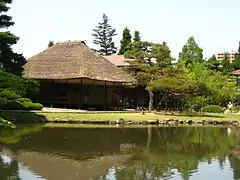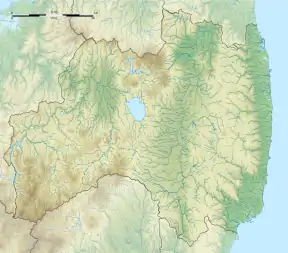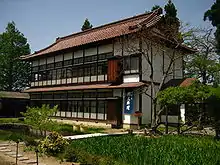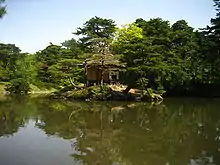Oyaku-en
Oyaku-en (御薬園) is a medicinal herb garden in the city of Aizuwakamatsu, Fukushima Prefecture, Japan. The garden was designated a Place of Scenic Beauty by the Japanese government in 1932.[1] It is also known as the Aizu Matsudaira-clan Garden (会津松平氏庭園, Aizu Matsudaira-shi teien).
| Oyaku-en | |
|---|---|
| 御薬園 | |
 The Ochayagoten tea house at Oyaku-en | |
 Oyaku-en  Oyaku-en (Japan) | |
| Type | Japanese garden |
| Location | Aizuwakamatsu, Fukushima, Japan |
| Coordinates | 37°29′29″N 139°56′36.2″E |
| Created | 1380s |
History
The garden was first established in the 1380s. In the 1430s Ashina Morihisa, the 10th feudal lord of the Ashina clan, believing it to be a sacred place, kept the garden as a villa.[2] In 1670, Hoshina Masatsune, the second daimyō of the Aizu Domain, cultivated various herbs in the garden, notably Korean ginseng. Private citizens were encouraged to grow herbs as well, so the garden became known as Oyakuen, or "medicinal herb garden".[3] Today there are about 400 kinds of medicinal herbs and trees cultivated in and around the garden. Meguro Jotei, a landscape gardener during the Edo period and disciple of Kobori Enshū, designed the current layout of the garden to show nature in miniature, which is typical of a Japanese garden. The garden pond is named Shinji no Ike and is shaped like the kanji character for "heart" (心). The rectangular garden has a perimeter of about 540 m and an area of about 1.7 ha.[4]
Chōyōkaku

The Chōyōkaku (重陽閣) was built on the ninth of September, a date known as chōyō in the Japanese calendar. In 1928, Princess Chichibu stayed at Chōyōkaku while visiting the garden. In 1973 the building was moved to its current location.
Ochayagoten
The Ochayagoten (御茶屋御殿) dates from the Muromachi period. It was built in the Izumidono style. Each room has at least four-and-a-half tatami mats. The building was used when lords, superior officials, merchants or general managers of the clan were invited to Aizu.
Rakujutei

The Rakujutei (楽寿亭) is a tea ceremony cottage built on Naka shima or "Middle Island". It has an alcove with a rail and thatched roof. Feudal lords and the executives of the clan would enjoy tea ceremony here.
References
- Aizuwakamatsu City (March 30, 2006). Aizu no shiteki fūkei (Aizu's Historical Scene) (in Japanese). Aizuwakamatsu, Fukushima: Hokuto Printing Co. p. 15.
- Fukudokuhon sakukei iinkai (June 30, 2006). Aizu no rekishi (History of Aizu) (in Japanese). Aizuwakamatsu Tourism Bureau Inc. p. 46.
- "English insertion to Japanese brochure titled "Oyakuen"". Aizuwakamatsu city: Aizuwakamatsu Tourism Bureau. n.d. Cite journal requires
|journal=(help)
Further reading
| Wikimedia Commons has media related to Oyaku-en. |
- Aizuwakamatsu Tourism Bureau Inc. (July 25, 2000). Oyakuen (in Japanese) (2nd ed.). Kitanihon Printing Co.
Notes
- "会津松平氏庭園" (in Japanese). Agency for Cultural Affairs.
- Aizuwakamatsu City: Aizu no shiteki fūkei (Aizu's Historical Scene), page 15.
- Aizu no rekishi (History of Aizu), page 46.
- Okyakuen brochure